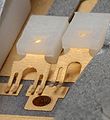Cam switches: Difference between revisions
Jump to navigation
Jump to search
No edit summary |
No edit summary |
||
| Line 1: | Line 1: | ||
Cam switches are used in many Tek instruments, particularly in 7000 series plug-ins, but also in 400-series portable scopes. | Cam switches are used in many Tek instruments, particularly in [[7000-series plug-ins]], but also in 400-series portable scopes. | ||
The lobes on the rotary cam encode the lookup table of which contacts should be open or closed in each rotational position of the shaft, | The lobes on the rotary cam encode the lookup table of which contacts should be open or closed in each rotational position of the shaft, | ||
which is typically rotated by a knob on the front panel of the instrument. | which is typically rotated by a knob on the front panel of the instrument. | ||
A benefit of this design is low parasitics compared to traditional rotary wafer switches. | A benefit of this design is low parasitics compared to traditional rotary wafer switches. | ||
==Maintenance== | |||
* [http://hakanh.com/dl/docs/kitinstructions/040-0541-00.pdf 040-0541-00: Cam switch repair kit (1970)] | |||
==Pictures== | |||
<gallery> | <gallery> | ||
Tek 7a19 frontright.jpg|Cam switch in [[7A19]] | Tek 7a19 frontright.jpg|Cam switch in [[7A19]] | ||
Revision as of 05:17, 5 December 2016
Cam switches are used in many Tek instruments, particularly in 7000-series plug-ins, but also in 400-series portable scopes.
The lobes on the rotary cam encode the lookup table of which contacts should be open or closed in each rotational position of the shaft, which is typically rotated by a knob on the front panel of the instrument. A benefit of this design is low parasitics compared to traditional rotary wafer switches.


